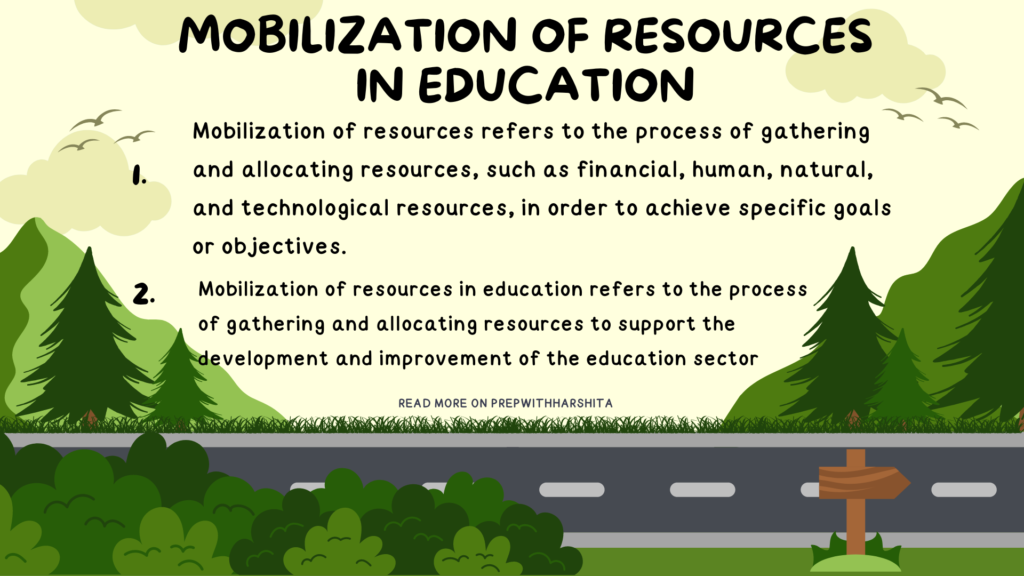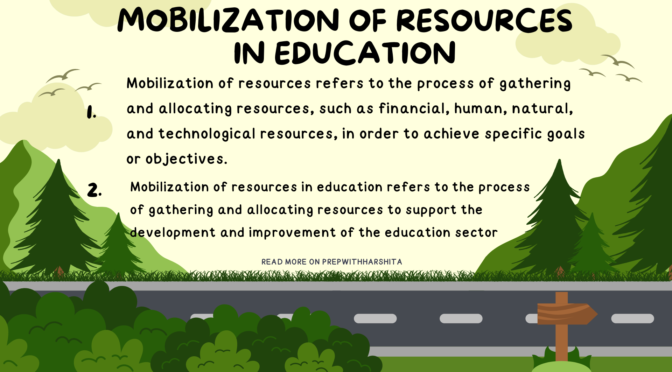Mobilization of resources refers to the process of gathering and allocating resources, such as financial, human, natural, and technological resources, in order to achieve specific goals or objectives.
This process is crucial for organizations, governments, and individuals who want to effectively utilize resources to achieve their desired outcomes.
Mobilization of resources in Education
Mobilization of resources in education refers to the process of gathering and allocating resources to support the development and improvement of the education sector. This can include financial, human, and technological resources.
- Financial resources can be mobilized through government budgets, private donations, grants, and other funding mechanisms. These resources can be used to improve infrastructure, provide better access to education, and enhance the quality of education by hiring qualified teachers, providing training and professional development opportunities, and investing in new technology and equipment.
- Human resources can also be mobilized by hiring qualified teachers, staff, and administrators who can help to improve the quality of education. Additionally, partnerships between schools, universities, and other educational institutions can help to provide access to additional human resources, such as guest lecturers or specialized instructors.
- Technological resources can also be mobilized by investing in digital infrastructure, such as providing access to computers, internet connectivity, and online learning resources. This can help to improve access to education and provide more flexible learning options for students.
Also read: Cost Analysis in Education
Features of Mobilization of resources in Education
- Needs assessment: Mobilization of resources in education requires a thorough needs assessment to identify the most critical needs of the education sector. This includes assessing infrastructure, resources, and staffing needs, as well as identifying gaps in the quality and accessibility of education.
- Strategic planning: Mobilization of resources in education also involves strategic planning to ensure that resources are allocated effectively to achieve desired outcomes. This may involve setting specific goals and objectives, identifying priorities, and developing action plans to allocate resources efficiently.
- Stakeholder engagement: Mobilization of resources in education requires engagement with a range of stakeholders, including government agencies, private donors, educational institutions, teachers, and students. This helps to ensure that resources are allocated in a way that reflects the needs and priorities of the education sector.
- Monitoring and evaluation: Mobilization of resources in education also requires ongoing monitoring and evaluation to track progress towards goals and identify areas where resources can be allocated more effectively. This includes measuring the impact of investments in education and identifying opportunities for improvement.
- Innovative solutions: Mobilization of resources in education also requires an innovative approach to finding new solutions and leveraging new technologies to improve the quality and accessibility of education. This may involve investing in new technologies, such as online learning platforms, to reach more students and provide more flexible learning options.
Effective mobilization of resources in education requires careful planning and management to ensure that resources are used efficiently and effectively toward achieving the desired outcomes.
This can involve developing strategies to identify critical needs, prioritizing resources, and monitoring progress to ensure that resources are being used optimally.


